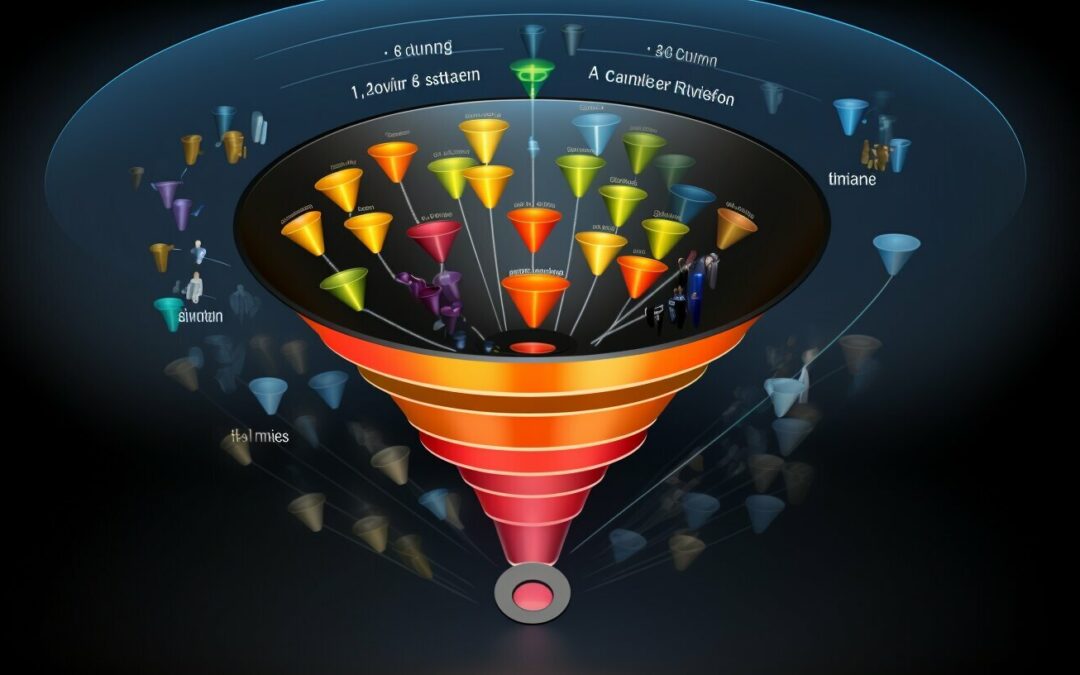Sales funnels are essential tools that can significantly enhance your business’s growth and revenue potential. A sales funnel is a systematic approach to tracking and converting leads into customers, guiding them through different stages of the buying process. By optimizing your sales funnel strategy, you can effectively nurture leads, improve conversion rates, and ultimately drive more sales.
Key Takeaways:
- Understanding the stages of a sales funnel – awareness, interest, decision, and action.
- Building an effective sales funnel by creating a compelling landing page, offering value, and nurturing leads.
- The importance of sales funnel optimization for revenue growth and customer experience.
- Implementing strategies such as understanding your target audience, creating engaging content, and reducing friction in the checkout process.
- Applying the AIDA model (Awareness, Interest, Decision, Action) to maximize the effectiveness of your sales funnel.
With a well-optimized sales funnel, you can convert more prospects into customers and make the most out of your marketing efforts. Stay tuned for the next sections where we dive deeper into each stage of the sales funnel and provide practical tips for successful implementation.
Understanding the Sales Funnel Stages
To effectively utilize sales funnels, it’s crucial to understand the different stages prospects go through before becoming customers. A sales funnel is a tool used to track leads as they progress from prospects to customers. It comprises three segments: top, middle, and bottom.
The top of the funnel is where prospects are attracted to your business through marketing strategies. This is the stage of awareness, where you grab the attention of potential customers and introduce them to your products or services. It is important to create informative content that educates and engages your audience, drawing them in with compelling messages and value propositions.
As prospects move through the funnel, they enter the middle stage, where their interest is further nurtured. This is the stage of engagement, where you build a relationship with your prospects and establish trust. Provide valuable resources, such as e-books, webinars, or free trials, to showcase your expertise and demonstrate the value you offer. Capture their email addresses to continue communication and guide them towards making a purchase decision.
The bottom of the funnel is the final purchase stage. At this stage, your prospects have made their decision and are ready to take action. It is crucial to make the purchasing process as smooth and simple as possible, reducing friction on checkouts and forms. Utilize engaging media, such as product videos or customer testimonials, to boost confidence and drive conversions. This is also the stage to continue communication and relationship-building to encourage customer loyalty and repeat business.
| Stage | Description |
|---|---|
| Top of the Funnel | Awareness – Attracting prospects through marketing strategies |
| Middle of the Funnel | Engagement – Nurturing and building relationships with prospects |
| Bottom of the Funnel | Purchase – Closing deals and maintaining communication |
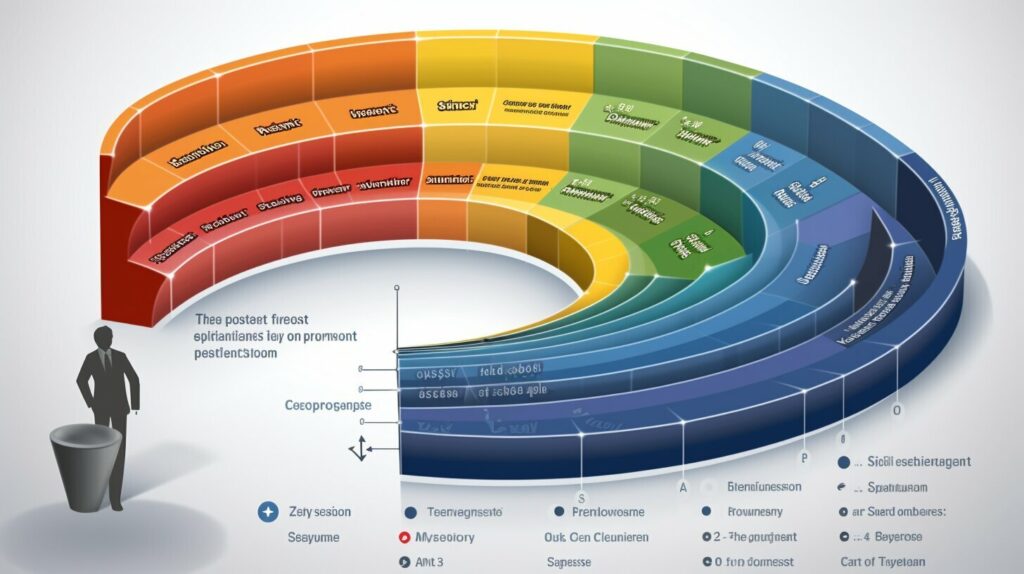
“The top of the funnel is where you create awareness, the middle is where you engage and nurture, and the bottom is where you close the deal.”
Key Points:
- A sales funnel consists of three segments: top, middle, and bottom.
- At the top of the funnel, prospects are attracted through marketing strategies.
- In the middle of the funnel, engagement and nurturing take place.
- The bottom of the funnel is where prospects make a purchasing decision.
Building an Effective Sales Funnel
Building an effective sales funnel requires a systematic approach that encompasses various strategies and techniques. It all starts with creating a compelling landing page that grabs your prospect’s attention and entices them to take action. A well-designed landing page should clearly communicate the value your business offers and provide a seamless user experience.
Once you have captured your prospect’s interest, it’s important to offer something valuable in exchange for their contact information. This could be in the form of a free e-book, a webinar, or a discount code. By providing something of value, you not only establish trust but also create an opportunity to nurture your leads further down the funnel.
Nurturing your leads is an essential step in the sales funnel process. This involves engaging with your prospects through personalized email campaigns, targeted content, and social media interaction. By staying top-of-mind and providing valuable information, you can build a relationship with your leads and guide them towards making a purchasing decision.
To close the deal, you need to make the buying process as smooth as possible. Streamlining your checkout process by minimizing friction and offering secure payment options can significantly improve conversion rates. Additionally, maintaining communication with your customers post-purchase is crucial for building loyalty and encouraging repeat business.
By following these steps and continuously analyzing and optimizing your sales funnel, you can maximize your business’s potential for growth and success. Implementing sales funnel automation and utilizing various sales funnel templates can further enhance your marketing efforts and streamline your processes, ultimately leading to increased revenue and customer satisfaction.
Table: Key Elements of an Effective Sales Funnel
| Stage | Strategy |
|---|---|
| Awareness | Create compelling ads and content to attract prospects. |
| Interest | Nurture leads with personalized emails and targeted content. |
| Decision | Provide clear product information and incentives to encourage purchase. |
| Action | Offer smooth checkout processes and continue post-purchase communication. |
Remember, building an effective sales funnel is an ongoing process. Continuously analyzing your performance, experimenting with different strategies, and adapting to your audience’s needs are essential for long-term success. By harnessing the power of sales funnel marketing, you can turn your prospects into loyal customers and propel your business to new heights.

Sales funnel optimization is a critical aspect of achieving business success, as it helps streamline the customer journey and enhance overall performance. By analyzing and refining each stage of the sales funnel, companies can increase conversion rates, improve customer experience, and maximize their return on investment.
One of the key benefits of sales funnel optimization is its ability to drive revenue growth. By identifying areas where prospects are dropping off or encountering obstacles, businesses can make informed decisions to improve conversions and ultimately generate more sales. This data-driven approach allows companies to allocate resources effectively and focus on strategies that have the greatest impact on their bottom line.
Another advantage of sales funnel optimization is its ability to enhance customer experience. By understanding the needs and preferences of your target audience, you can tailor your messaging, content, and offers to resonate with prospects at each stage of the funnel. This personalized approach not only increases engagement but also builds trust and loyalty, leading to long-term customer relationships.

By leveraging sales funnel analytics, businesses can gain valuable insights into customer behavior, preferences, and pain points. These analytics provide a wealth of data that can help identify trends, uncover opportunities, and make data-driven decisions. Whether it’s tracking conversion rates, analyzing website traffic, or measuring the effectiveness of marketing campaigns, sales funnel analytics provide the necessary information to optimize performance and drive business growth.
| Benefits of Sales Funnel Optimization |
|---|
| Increased conversion rates |
| Improved customer experience |
| Maximized return on investment |
| Enhanced data-driven decision-making |
Sales funnel optimization is a vital component of any successful business strategy. By continuously monitoring and refining each stage of the funnel, companies can improve conversions, enhance customer experience, and drive revenue growth. Utilizing sales funnel analytics and insights, businesses can make data-driven decisions and capitalize on opportunities to maximize their return on investment. Remember, a well-optimized sales funnel not only helps attract and convert prospects but also builds strong and lasting customer relationships. Invest the time and resources into optimizing your sales funnel, and you’ll reap the rewards in increased sales and customer satisfaction.
Key Strategies for Sales Funnel Optimization
To maximize conversion rates and drive more sales, it’s vital to implement effective strategies at every stage of your sales funnel. From attracting prospects to closing deals, each step presents an opportunity to optimize your funnel for better results. Here are some key strategies to consider:
1. Understand Your Target Audience
Before you can optimize your sales funnel, you need a deep understanding of your target audience. Conduct market research, analyze customer data, and create buyer personas to identify their needs, preferences, and pain points. This knowledge will help you tailor your messaging and offerings to resonate with your audience, increasing the chances of conversion.
2. Create Informative and Engaging Content
Content is the backbone of any successful sales funnel. To keep prospects engaged and move them through the funnel, create informative and engaging content such as blog posts, videos, and social media posts. Focus on providing value, addressing their pain points, and showcasing your expertise. By offering valuable content, you build trust and establish yourself as a thought leader in your industry.
3. Capture Prospect’s Email Address
Email marketing is a powerful tool for nurturing leads and driving conversions. To capture a prospect’s email address, offer an irresistible lead magnet such as a free e-book, checklist, or webinar. This allows you to stay in touch with prospects, send them relevant content, and guide them further down the funnel. Personalize your email campaigns based on the prospect’s interests and behavior to maximize engagement and conversions.
4. Use Compelling Media
Visual and interactive media can greatly enhance your sales funnel. Incorporate compelling images, videos, and infographics to grab attention, convey your message, and leave a lasting impression. Visual content is more engaging and memorable, making it more likely for prospects to take the desired action. Use high-quality visuals that align with your brand and resonate with your target audience.
5. Reduce Friction During Checkouts and Forms
When prospects are ready to make a purchase, it’s crucial to streamline the checkout process and minimize any potential friction. Optimize your website’s user experience, simplify forms, and offer multiple payment options to ensure a smooth and hassle-free buying experience. The easier it is for prospects to complete the purchase, the higher the chances of conversion.
| Sales Funnel Strategy | Sales Funnel Conversion | Sales Funnel Tracking |
|---|---|---|
| Understand Your Target Audience | Create Informative and Engaging Content | Capture Prospect’s Email Address |
| Use Compelling Media | Reduce Friction During Checkouts and Forms |
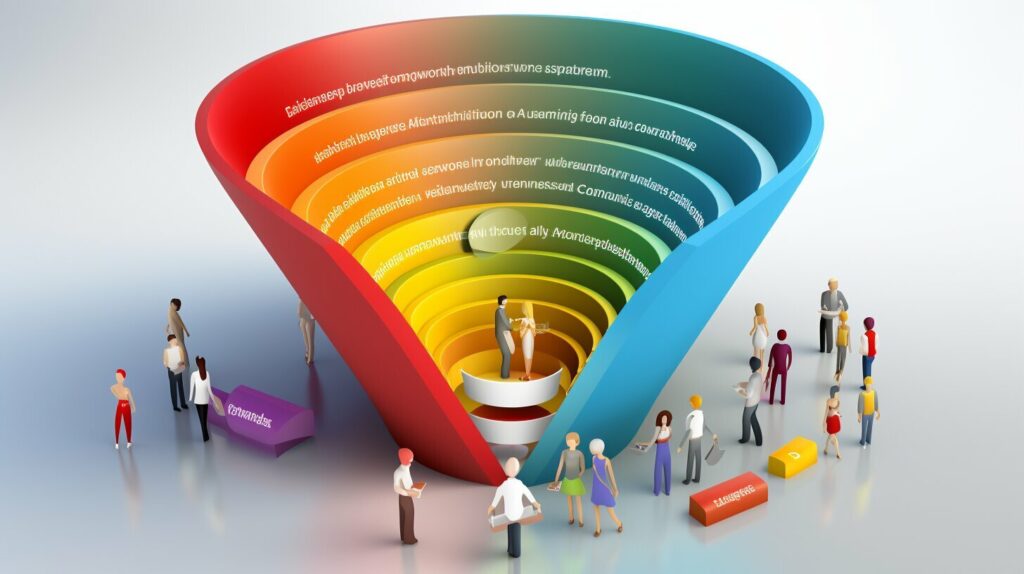
The AIDA model provides a useful framework for guiding prospects through the sales funnel and converting them into customers. By understanding and leveraging the stages of AIDA – Awareness, Interest, Decision, and Action – businesses can effectively engage with their target audience and drive successful conversions.
In the awareness stage, prospects become acquainted with your brand and offerings. It is crucial to create awareness through targeted marketing strategies, such as search engine optimization (SEO), social media advertising, and content marketing. By generating interest in your products or services, you can encourage prospects to move to the next stage of the funnel.
During the interest stage, prospects demonstrate a higher level of engagement and actively seek more information. This is an opportunity to provide valuable and informative content that addresses their pain points and positions your business as a trusted authority. Use engaging media, such as videos or interactive graphics, to capture and maintain their interest.
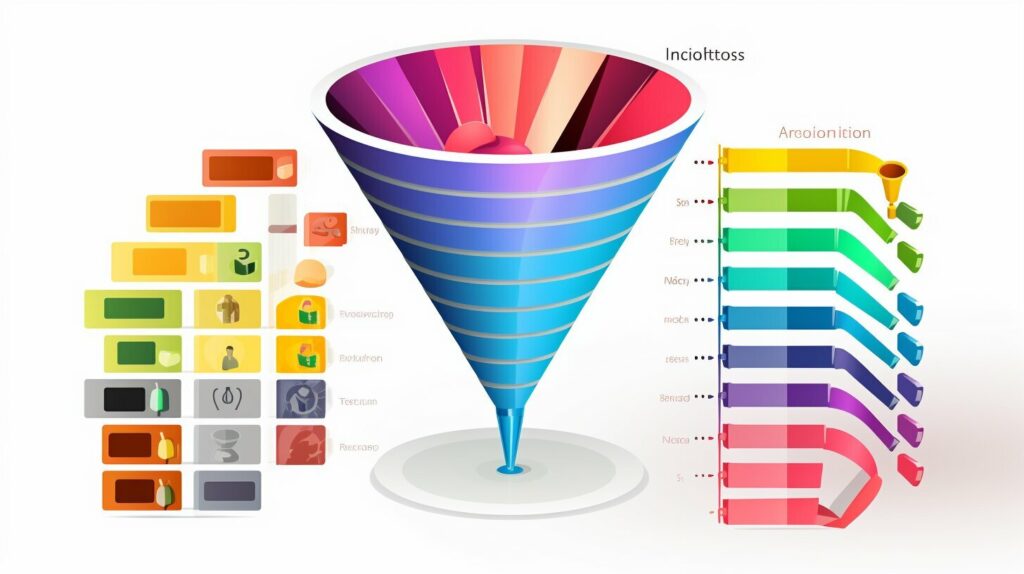
The decision stage is where prospects evaluate their options and make a purchasing decision. To facilitate this process, offer compelling incentives, such as discounts or limited-time offers, and provide social proof, such as testimonials or case studies, to build trust. Make it easy for prospects to take action, whether it’s making a purchase, requesting a demo, or subscribing to a newsletter.
Finally, the action stage is where prospects convert into customers by completing the desired action. This could be making a purchase, signing up for a service, or requesting more information. Streamline the checkout process, minimize friction, and provide clear instructions to ensure a seamless transition from prospect to customer.
Summary:
The AIDA model offers a systematic approach to guide prospects through the sales funnel. By creating awareness, generating interest, facilitating the decision-making process, and encouraging action, businesses can optimize their sales funnel strategy and increase conversion rates. Understanding the stages of AIDA and applying them effectively can drive revenue growth, improve customer experience, and maximize ROI for businesses of all sizes.
| Stage | Description |
|---|---|
| Awareness | Prospects become aware of your brand and offerings. |
| Interest | Prospects show an interest in your products or services and seek more information. |
| Decision | Prospects evaluate their options and make a purchasing decision. |
| Action | Prospects convert into customers by completing the desired action. |
Leveraging Sales Funnel Software
Sales funnel software offers a range of tools and features that can significantly simplify and optimize your sales process. Whether you are a small business owner or a seasoned marketer, leveraging sales funnel software can help you streamline your operations, track leads, and increase conversions. With the right software, you can automate various aspects of your sales funnel, saving you time and resources.
One of the key advantages of using sales funnel software is the ability to track and analyze the performance of your sales process. The software can provide you with valuable insights into how prospects move through your sales funnel, allowing you to identify bottlenecks and areas for improvement. By understanding and addressing these pain points, you can optimize your sales funnel and maximize your conversion rates.
Another benefit of sales funnel software is its ability to automate repetitive tasks, such as lead capture and nurturing. With the software, you can create landing pages, capture prospect information, and send targeted emails automatically. This not only saves you time and effort but also ensures a consistent and personalized experience for your prospects. Moreover, sales funnel software often integrates with popular email marketing platforms, further enhancing your ability to nurture leads and drive conversions.
Table: Key Features of Sales Funnel Software
| Feature | Description |
|---|---|
| Lead Tracking | Track and monitor the progress of leads as they move through your sales funnel. |
| Email Marketing Integration | Seamlessly integrate with popular email marketing platforms to automate email campaigns and lead nurturing. |
| Analytics and Reporting | Gain valuable insights into the performance of your sales funnel, identify areas for improvement, and make data-driven decisions. |
| Automation | Automate repetitive tasks, such as lead capture, email follow-ups, and appointment scheduling, to save time and increase efficiency. |
| CRM Integration | Integrate with your customer relationship management (CRM) system to streamline data management and enhance customer relationships. |
By leveraging sales funnel software, you can take your sales process to the next level. From tracking leads and automating tasks to analyzing data and optimizing conversions, the right software can be a game-changer for your business. Explore the different sales funnel software options available and find the one that best fits your needs and budget. It’s time to supercharge your sales funnel and drive business growth.

Case Studies: Successful Sales Funnel Implementations
Examining successful case studies can provide valuable insights and inspiration for implementing and optimizing your own sales funnel. Let’s take a closer look at two businesses that have achieved impressive results through strategic sales funnel optimization.
Case Study 1: Company A – Boosting Conversion Rates
Company A, a B2B software provider, successfully improved their sales funnel conversion rates by implementing data-driven strategies. By utilizing sales funnel analytics, they identified a significant drop-off in the middle of their funnel. To address this, they revamped their content marketing strategy, incorporating informative blog posts, whitepapers, and case studies to educate and engage prospects.
Additionally, Company A created personalized email campaigns to nurture leads and encourage them to move through the sales funnel. By tailoring their messaging to the specific needs and pain points of their audience, they saw a substantial increase in engagement and conversion rates.
| Metric | Before Optimization | After Optimization |
|---|---|---|
| Conversion Rate | 2.5% | 7.2% |
| Revenue | $500,000 | $1.2 million |
| Customer Acquisition Cost | $1500 | $900 |
Case Study 2: Company B – Optimizing the Checkout Process
Company B, an e-commerce retailer, focused on enhancing their bottom-of-the-funnel experience to minimize cart abandonment and improve sales. Through extensive testing and optimization, they streamlined their checkout process, making it more user-friendly and reducing friction. They simplified forms, added progress indicators, and implemented a guest checkout option to eliminate unnecessary barriers.
In addition, Company B leveraged persuasive product videos and customer testimonials to instill confidence in their prospects and increase conversions. By delivering a seamless purchasing experience and addressing common concerns, they achieved remarkable results.
“Our sales funnel optimization efforts have not only increased our revenue but also improved customer satisfaction. By analyzing customer behavior and making data-driven changes, we’ve been able to create a frictionless buying process that drives results.” – Company B
| Metric | Before Optimization | After Optimization |
|---|---|---|
| Cart Abandonment Rate | 75% | 25% |
| Average Order Value | $50 | $75 |
| Conversion Rate | 3% | 6% |
These case studies highlight the power of sales funnel optimization in driving business growth and maximizing results. By understanding their target audience, analyzing data, and implementing effective strategies, businesses can enhance customer experience, increase conversion rates, and ultimately boost revenue. Take inspiration from these success stories to optimize your own sales funnel and achieve your business goals.
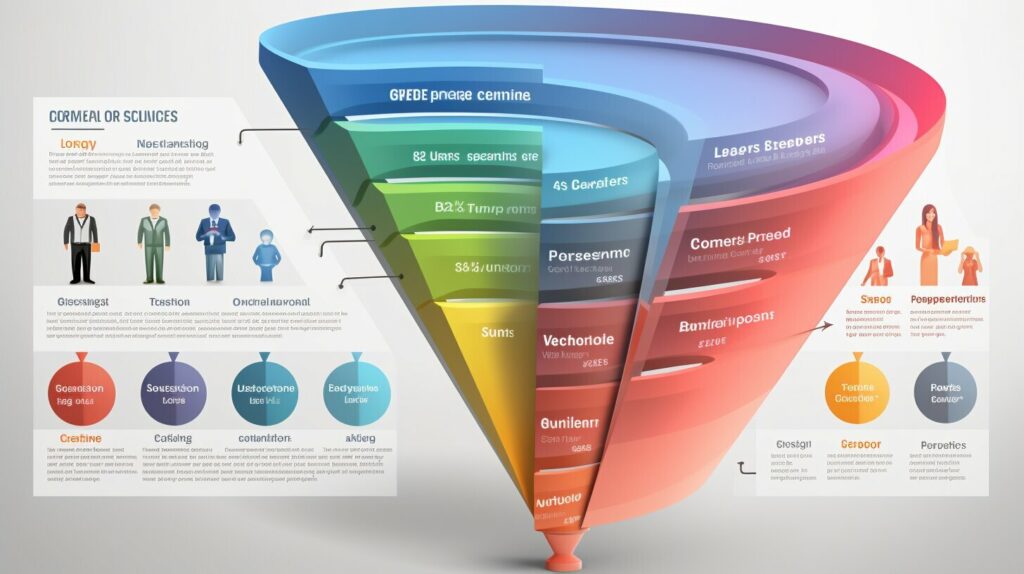
In conclusion, mastering the art of sales funnels is essential for businesses looking to maximize their growth potential, and OCEANONE Leads is here to help you achieve exceptional results.
A sales funnel is a powerful tool that allows you to track leads as they progress from prospects to customers. Comprising three segments – top, middle, and bottom – a sales funnel guides your prospects through the stages of awareness, interest, decision, and action.
To build an effective sales funnel, it is important to create a compelling landing page that captures your prospects’ attention. Offering something valuable, such as a free guide or a discount, can entice prospects to engage with your business. Nurturing your leads through personalized communication and building strong relationships is crucial for closing deals.
Once your sales funnel is up and running, it is important to optimize each stage to increase conversion rates and drive more sales. Understanding your target audience, creating informative and engaging content, capturing prospects’ email addresses, using compelling media, and reducing friction in the checkout process are key strategies for achieving this.
At OCEANONE Leads, we understand the importance of sales funnel optimization in driving revenue growth, improving customer experience, and maximizing ROI. Our team of experts is dedicated to helping businesses like yours achieve exceptional results through effective sales funnel strategies, automation, and analytics. Contact us today to take your business to new heights with the power of sales funnels.
FAQ
What is a sales funnel?
A sales funnel is a tool used to track leads as they progress from prospects to customers.
What are the stages of a sales funnel?
The stages of a sales funnel are awareness, interest, decision, and action.
How do I build a sales funnel?
To build a sales funnel, you need to create a landing page, offer something valuable, nurture the prospect, close the deal, and continue the communication and relationship-building process.
Why is sales funnel optimization important?
Sales funnel optimization is important for driving revenue growth, improving customer experience, and maximizing ROI.
What strategies can I use to optimize my sales funnel?
Key strategies for sales funnel optimization include knowing your audience, creating informative content, capturing the prospect’s email address, using engaging media, and reducing friction on checkouts and forms.
How can I apply the AIDA model to sales funnels?
The AIDA model (Awareness, Interest, Decision, Action) can be applied to sales funnels by creating awareness, generating interest, facilitating the decision-making process, and encouraging prospects to take action.
What are the benefits of using sales funnel software?
Sales funnel software can streamline and automate various aspects of the sales funnel, including lead tracking, email marketing integration, and analytics.
Are there any real-life case studies of successful sales funnel implementations?
Yes, there are case studies showcasing businesses that have successfully implemented sales funnels to achieve remarkable results. These case studies highlight specific strategies, tactics, and metrics that contributed to their success.

